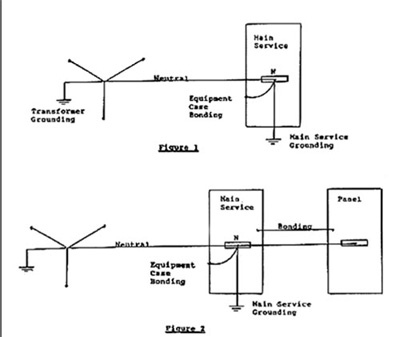Electrical system grounding is not widely understood,and it may lead to many different discussions, interpretations and a wide variation of philosophies. This article reviews some of the electrical system grounding requirements as spelled out in the Canadian Electrical Code and it throws in a few curve balls to hopefully keep things interesting.
The CEC Rule 10-106 requires that alternating current systems must always be grounded when their voltage-to-ground is 150 volts to ground or less, or when the electrical system has a neutral conductor. In general, this requirement would apply to both 208Y/120-volt and 120/240-volt systems.
Rule 10-204 tells us that neutral connections to ground must be made at the main service equipment and again at the transformer that supplies the utilization voltage. But the rule specifies there must be no neutral connections to ground anywhere in the electrical system past the main service equipment (see figures 1 and 2). If there is bonding between the cases of electrical equipment and the system neutral downstream from the main electrical service, the bonding must be removed.

Figures 1 and 2
You might be justified in asking why the CEC prohibits all interconnections between the electrical system neutral and the case of the equipment downstream from the main electrical service. Two good reasons come to mind:
1. an inadvertent parallel return path for load currents is created when the neutral becomes grounded anywhere past its grounding point at the main service; and
2. if the main electrical service has ground-fault protection of the zero sequence or residually connected types, grounding the neutral downstream from the fault sensing equipment will effectively disable the groundfault protection.
I’m sure that none of this is news to you. But how can unintentional grounding show up in your electrical system that violates the CEC and creates the problems discussed? An emergency standby generator could be one way. The frames of some generators are bonded to the generator neutral. This information should be noted somewhere on the machine. Connecting this type of standby generator to an electrical system will create an unintended downstream ground point. A 4-pole transfer switch is then required to ensure this doesn’t become a problem, by ensuring the generator neutral is disconnected at all times when the machine is not in operation.
Another way that an unplanned downstream ground can show up is by the installation of electrical equipment such as a panelboard that has a bonding screw or bonding jumper connecting its neutral bar to the case of the equipment. These should always be removed to avoid the above problems, since bonding to the case will create accidental downstream grounding. But as you know, there is one exception to this rule. Rule 10-208 specifies that when two or more buildings are supplied from a single service, either:
1. the service neutral may be grounded at each of the buildings; or
2. the system neutral is grounded only at the main electrical service.
One frequent example would be when a building is supplied as a feeder from another building. In this example, the neutral may be grounded at the service entrance of each building, but there must be no bonding conductor between the two buildings, since the service equipment is already bonded to the system neutral in each building. Adding bonding between the two buildings would create a parallel neutral conductor.
You should note that this is the only grounding arrangement permitted by the CEC if the second building will contain livestock.
A second grounding arrangement is also permitted. In this scheme, the system neutral is grounded only at the main service in the first building. The case of service equipment in the second building must not be bonded to the neutral, since it creates an additional grounding point. However, a bonding conductor must be installed between services in the two buildings; otherwise, there would be no effective return path for ground-fault currents.
As with previous articles, you should always check with the electrical inspection authority in each province or territory for a more precise interpretation of any of the above.














Find Us on Socials